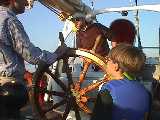
Thursday, June 19, 1999
23:00, Woods Hole dock; stratus, 1030 mb
This has been an introduction to SEA that I did not expect. The
alumni weekend festivities have transformed what I thought would
be a step by step transfer of lab procedures and protocols into a
hands on dervish of lessons -- in sailing, science assistance, and
the culture of the Cramer. While the learning curve was near
vertical during Whit's orientation to the lab, it became overhanging
today as the day sails exposed me to a bewildering number of sheets,
halyards, hardware, and rusty sail jargon.
 To be sure, it must be astounding to captain such a vessel with the
same confidence and sensitivity that I feel aboard a laser or the
Triptych. Some kind C153(?) students (including Sharon from
Stanford Earth Systems) advised me to maintain motivation and a
sense of simplicity in the lab so that I can find the time to helm,
shoot the stars, and stand a bow watch. One mentioned that he
wished that the assistant scientist had simply told him that some
scientific duties (100 counts) must be done. To drone on about
the foremost goal being attainment of fun did not inspire the art
history major to persevere. Another forewarned that the SEA high
is lofty and the low is profound, and that the transitions can be
nearly instantaneous.
To be sure, it must be astounding to captain such a vessel with the
same confidence and sensitivity that I feel aboard a laser or the
Triptych. Some kind C153(?) students (including Sharon from
Stanford Earth Systems) advised me to maintain motivation and a
sense of simplicity in the lab so that I can find the time to helm,
shoot the stars, and stand a bow watch. One mentioned that he
wished that the assistant scientist had simply told him that some
scientific duties (100 counts) must be done. To drone on about
the foremost goal being attainment of fun did not inspire the art
history major to persevere. Another forewarned that the SEA high
is lofty and the low is profound, and that the transitions can be
nearly instantaneous.
 Tomorrow I will remain calm and try to get my head around the big
picture: what daily life aboard will be like, and how I want it to
be. How shall I exercise? Are the students projects or the
track-specific research stations a higher priority? From the
students' perspectives, what are the objectives of the scientific
exercises? How can we best instill a sense of the oceans?
Tomorrow I will remain calm and try to get my head around the big
picture: what daily life aboard will be like, and how I want it to
be. How shall I exercise? Are the students projects or the
track-specific research stations a higher priority? From the
students' perspectives, what are the objectives of the scientific
exercises? How can we best instill a sense of the oceans?
Previous Entry |
Return to Logbook Contents
Next Entry
 To be sure, it must be astounding to captain such a vessel with the
same confidence and sensitivity that I feel aboard a laser or the
Triptych. Some kind C153(?) students (including Sharon from
Stanford Earth Systems) advised me to maintain motivation and a
sense of simplicity in the lab so that I can find the time to helm,
shoot the stars, and stand a bow watch. One mentioned that he
wished that the assistant scientist had simply told him that some
scientific duties (100 counts) must be done. To drone on about
the foremost goal being attainment of fun did not inspire the art
history major to persevere. Another forewarned that the SEA high
is lofty and the low is profound, and that the transitions can be
nearly instantaneous.
To be sure, it must be astounding to captain such a vessel with the
same confidence and sensitivity that I feel aboard a laser or the
Triptych. Some kind C153(?) students (including Sharon from
Stanford Earth Systems) advised me to maintain motivation and a
sense of simplicity in the lab so that I can find the time to helm,
shoot the stars, and stand a bow watch. One mentioned that he
wished that the assistant scientist had simply told him that some
scientific duties (100 counts) must be done. To drone on about
the foremost goal being attainment of fun did not inspire the art
history major to persevere. Another forewarned that the SEA high
is lofty and the low is profound, and that the transitions can be
nearly instantaneous.
